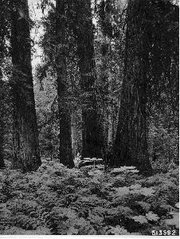Northern Rocky Mountain Forest-Steppe - Coniferous Forest - Alpine Meadow Province
Contents
Northern Rocky Mountain Forest-Steppe - Coniferous Forest - Alpine Meadow Province (Bailey)
Northern Idaho, western Montana, eastern Washington, 38,100 mi2 (98,700 km2)
Land-surface form
The Northern Rocky Mountain Province consists of high, rugged mountains rising to more than 9,000 ft (2,700 m), with a local relief in excess of 3,000 ft (900 m). Most of the region has been glaciated. In the several Rocky Mountain trenches, there are flat or nearly flat valleys, some of which are several miles wide.
Climate
Severe winters are usual. The average temperature of the coldest month is below 32°F (0°C), and the average temperature of the warmest month is below 72°F (22°C). Summer days are often hot and nights cool. Precipitation averages 20 to 40 in (510 to 1,020 mm) per year and is concentrated in fall, winter, and spring. Summers are usually dry, because westerly air masses draw the dry climate of the Pacific coast across the area. As a result, there is a distinct climatic gradient from north to south and east to west. Snowfall in winter is heavy, but permanent snowfields and glaciers cover only rather small areas.
Vegetation
Mixed evergreen-deciduous forest predominates; Douglas-fir forest and cedar-hemlock-Douglas-fir forest are the two major types.
Well-marked life belts are a striking feature of the province. In the uppermost (alpine) belt, trees are absent. The subalpine belt is dominated in most places by Engelmann spruce and subalpine fir. In the Bitterroot Range, mountain hemlock is said to be the climax tree of the subalpine belt. Western red cedar and western hemlock are characteristic of the montane belt. Associated trees include Douglas-fir (found throughout the region), along with western white pine, western larch, grand fir, and western ponderosa pine (found in the south). In these forests, areas that have been burned or cut are invaded first by larch, a deciduous conifer. White pine may crowd out the larch, then be replaced by hemlock, red cedar, and lowland white fir. Depending on latitude, the lower part of the montane belt may be interspersed with grass and sagebrush.
Soils
Soils are mostly cool, moist Inceptisols. A variety of igneous, sedimentary, and metamorphic rocks form the mountain masses. But compared to other parts of the Rocky Mountains, the shallowness and stoniness of soils play a relatively minor role in forest distribution. In the foothills of the Rockies and to the south of the glacial border, the loess and volcanic ash deposited on the slopes have helped to form excellent soils.
Fauna
Large mammals in this province include black bear, deer, elk, mountain goat, mountain lion, and bobcat. Smaller mammals include Columbia ground squirrel, flying squirrel, marten, redtail chipmunk, and bushytail woodrat.
Some familiar birds are hawks, jays, chestnut-backed chickadees, red-breasted nuthatches, and great gray owls. Blue and ruffed grouse are the most common game birds.
Return to Ecoregions of the United States
| Disclaimer: This article is taken wholly from, or contains information that was originally published by, the United States Forest Service. Topic editors and authors for the Encyclopedia of Earth may have edited its content or added new information. The use of information from the United States Forest Service should not be construed as support for or endorsement by that organization for any new information added by EoE personnel, or for any editing of the original content. |
